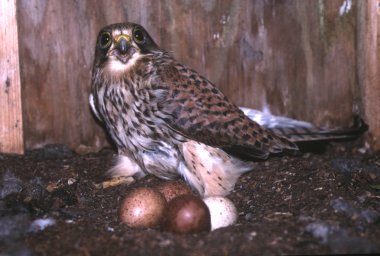Kestrels For
Company
available in bookstores
Satellite tagging of young kestrels
Annual kestrel summaries - Scotland

Annual Report 2003
As expected there was a pick up of vole numbers and this, along with a good spell of weather in February and March, saw early activity at nesting territories with birds present and nest sites scraped. The increase in occupation was most marked in the main upland study area with nine territories occupied compared to three in 2002. The healthy colonization of many territories by buzzard and barn owl continues but several woods, occupied for years by kestrels, are now vacant. The extra competition for food should not be ruled out as a possible factor in this change of status as there are very few territories where kestrel and buzzard breed together.
The good weather was a feature of the season and only a wet spell in May marred the otherwise excellent conditions. Occupancy was up to 66% of territories checked from 44% the previous year. The first egg was recorded on 31 March, in the wood that invariably hosts the pair with the earliest clutch. In general the pairs which bred did extremely well with clutch sizes at a healthy 5.46. All families were in the air by early July.

2003 breeding statistics were as follows :-
|
|
2003 |
2002 |
2001 |
|
Number of territories checked
|
30 |
34 |
24 |
|
% occupation
|
66 |
44 |
70 |
|
Number of clutches known
|
13 |
9 |
15 |
|
Average clutch size
|
5.46 |
4.4 |
5 |
|
% of eggs which hatched
|
83 |
82 |
76 |
|
Number of results known
|
20 |
12 |
17 |
|
Average young per breeding pair
|
3.1 |
2.75 |
3.8 |
|
Average young per successful pair
|
3.9 |
4.1 |
4.6 |
|
Number of breeding attempts failed
|
4 |
4 |
3 |
|
% failed
|
20 |
33 |
23 |
|
% brood survival
|
91 |
82 |
98 |
|
Number of young ringed
|
40 |
30 |
44 |
|
Number of adults ringed
|
4 |
5 |
0 |
Of the four adults caught, only one was a new bird. The other three, all females, were caught in territories which they had previously bred in, a previous year’s bird, one which first bred in a territory in 2000 and the oldest which was first caught in 1998.
